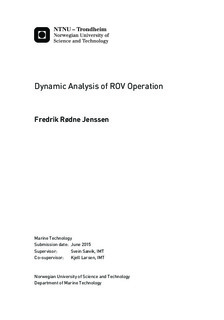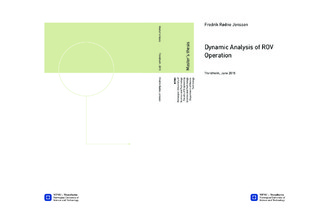| dc.description.abstract | At the semi-submersible rig Snorre B, the work class remotely operated vehicle (WROV) is essential to perform drilling and production activities. Currently, the weather criterion for launching the ROV is set to four meters significant wave height. This leads to restrictions for subsea operations dependent on the ROV. The weather criterion is based on simplified calculations from DNV's Recommended Practice, which is suspected to overestimate the forces due to assumptions and uncertainties.
In this work, the launch and recovery operation has been evaluated based on time domain analysis in SIMO and motion measurements of the ROV. In addition, simplified calculations have been conducted for comparison. The intention has been to determine critical factors when setting the weather criterion for the operation. Further, measures to reduce the effect of the critical factors have been evaluated.
A preliminary model of the ROV and the launch and recover system was made in the project thesis work during the fall semester in 2014. This model has been modified and verified to give a better representation of the operation. Further, the model has been used to understand the background for effects influencing the weather criterion. Based on the results, a representation of the sheave suspension mounted at Snorre B was included by two methods. Accelerations, angular velocities and orientation measurements were done by mounting an inertial measurement unit on the ROV. This was used to evaluate the actual behaviour of the ROV, and to some extend verify the SIMO results.
Based on the SIMO analysis, large snap loads in the umbilical during launch is identified as a critical factor. This is a consequence of slack umbilical due to drag force from vertical water particle velocity. The recovery phase and pontoon impact risk are of less importance for the weather criterion. Occurrence of snap load in the umbilical is also indicated from the motion measurements. Horizontal accelerations in the wave zone were in the same magnitude as the results from SIMO. However, lack of position references and uncertainties in the measurements makes them difficult to verify.
Because of the snap loads, an effective sheave suspension system seems to be the best option to reduce the dimensioning forces. The two sheave suspension stiffness models in SIMO reduced the umbilical tension during snap loads, but did not reduce the duration of slack umbilical. However, simplifications of the system and uncertainties in input parameters makes it difficult to evaluate the effect. Assuming measured impulse acceleration is due to a snap load, the measurements can indicate limited effect of the current sheave suspension system. | |

